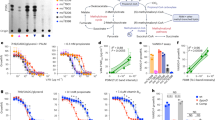Abstract
IN a recent communication, Somers1 has again considered the hypothesis first proposed by Mathews2, that the toxicity of metal ions is related to the electrode potential of the metal. He has plotted the negative logarithms of the ED50 values of the applied molar concentrations of 21 elements for conidia of Alternaria tenuis against the electronegativity of the elements. An examination of the curve indicates clearly a correlation between the electronegativity and toxicity in the data presented. This is especially fortified by the low electronegativity of magnesium, strontium, lithium, sodium, barium and potassium ions which are basically not toxic to fungus conidia. If, however, attention is confined to that part of the curve which deals with ions toxic to fungus conidia (ions as toxic and more toxic than zinc), it is apparent that in a number of instances, the ED50 values are several orders of magnitude higher or lower than if they fell on the line drawn. As a matter of fact, examination of the data for these 15 elements, by calculating the rank correlation coefficient (calculated by Dr. F. Wilcoxon, Boyce Thompson Institute), shows that there is no significant correlation between electronegativity and toxicity in the area in which the toxic elements are found.
This is a preview of subscription content, access via your institution
Access options
Subscribe to this journal
Receive 51 print issues and online access
$199.00 per year
only $3.90 per issue
Buy this article
- Purchase on Springer Link
- Instant access to full article PDF
Prices may be subject to local taxes which are calculated during checkout
Similar content being viewed by others
References
Somers, E., Nature, 184, 475 (1959).
Mathews, A. P., Amer. J. Physiol., 10, 290 (1904).
Miller, L. P., McCallan, S. E. A., and Weed, R. M., Contrib. Boyce Thompson Inst., 17, 173 (1953).
Miller, L. P., McCallan, S. E. A., and Weed, R. M., Contrib. Boyce Thompson Inst., 17, 283 (1953).
Miller, L. P., McCallan, S. E. A., and Weed, R. M., Proc. Second Radioisotope Conf., Oxford, 1, 381 (1954).
Miller, L. P., McCallan, S. E. A., Proc. Intern. Conf. on Peaceful Uses of Atomic Energy, 12, 170 (1956).
Miller, L. P., and McCallan, S. E. A., J. Agric. Food Chem., 5, 116 (1957).
Burchfield, H. P., and Storrs, E. E., Contrib. Boyce Thompson Inst., 18, 429 (1957).
Owens, R. G., and Novotny, H. M., Contrib. Boyce Thompson Inst., 20, 151 (1959).
Miller, L. P., and McCallan, S. E. A., Science, 126, 1233 (1957).
Owens, R. G., and Miller, L. P., Contrib. Boyce Thompson Inst., 19, 177 (1957).
Author information
Authors and Affiliations
Rights and permissions
About this article
Cite this article
MILLER, L. Fungitoxicity of Metal Ions. Nature 185, 545–546 (1960). https://doi.org/10.1038/185545a0
Issue Date:
DOI: https://doi.org/10.1038/185545a0
This article is cited by
-
Fungitoxicity of Metal Ions
Nature (1960)
Comments
By submitting a comment you agree to abide by our Terms and Community Guidelines. If you find something abusive or that does not comply with our terms or guidelines please flag it as inappropriate.



